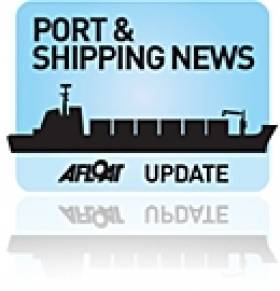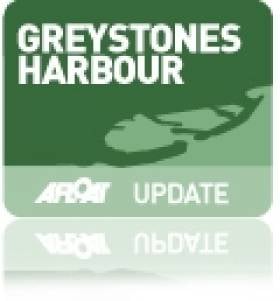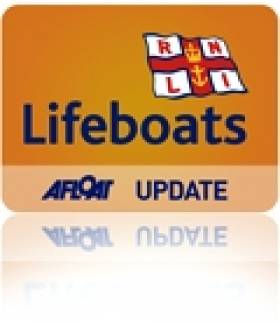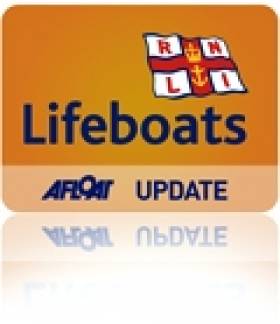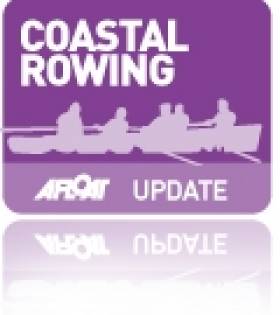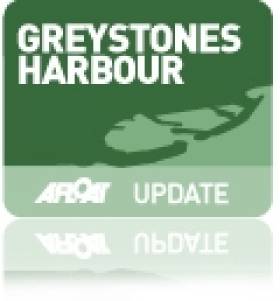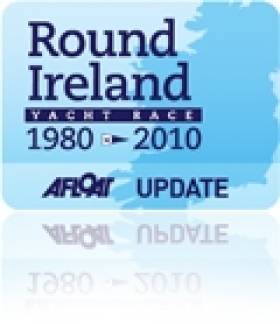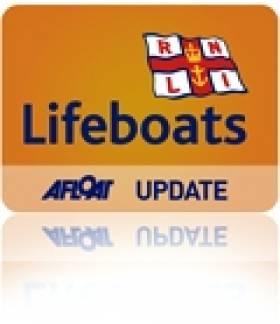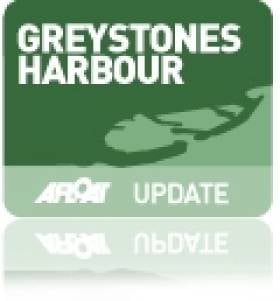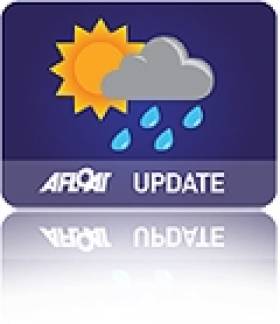Displaying items by tag: Wicklow
Cargoship Gets into Scrap in Wicklow
The cargoship Arklow Rebel (2,999 gross tonnes) which loaded scrap metal in Wicklow Port today, is believed to be the largest Arklow Shipping Ltd vessel to dock in the east coast port, writes Jehan Ashmore.
The 7-year old Dutch-built vessel arrived in ballast from Warrenpoint Co. Down around 01.30hrs to berth alongside the town's south quays at the Packet Quay.
Throughout this afternoon there was a steady stream of lorries laden with the scrap-metal which was loaded into the ship's hull by a quayside grabber. Upon completion of loading, the distinctive green hulled Arklow Rebel departed this evening bound for Liverpool.
She is one of nine 'R'class series of ships built by the Dutch shipyard of Barkmeijer Stroobos B.V. and has the following dimensions (90m length X 12m breath X 4m draft). For further vessel characteristics click HERE.
The Irish-flagged vessel is registered at the neighbouring port of Arklow to the south and is part of a fleet of over 40 ships managed by the Tyrrell family.
During the boom years Wicklow port was particularly busy with Scandinavian imports of bundled packaged timber and plasterboard for the construction industry.
The tidal port at the mouth of the River Leitrim also specialises in paper, lead, steel and dry bulk cargoes, principally coal in addition to other general and heavy-lift project cargoes.
For many years the issue of road traffic congestion was finally solved when the Wicklow Port Access and Town Relief Road Scheme was completed in April of last year.
The port access road (1.6km) runs between the Rathnew Road to The Murrough via a bridge that crosses the Broadlough Estuary and over the Dublin-Rosslare railway line.
- Wicklow
- Arklow Shipping Ltd
- Wicklow harbour
- Liverpool
- ASL
- Wicklow Port
- Port of Wicklow
- Wicklow Port Access and Town Relief Scheme
- Arklow Rebel
- Tyrrell
- ScrapMetal
- Port and Shipping News
- Packet Quay Wicklow
- Wicklow Port Company
- Broadlough Estuary
- River Leitrim
- The Murrough
- DublinRosslare railway line
- Barkmeijer Stoobos B.V.
Parts of Greystones Harbour to Reopen to the Public
Parts of the paused development of Greystones Harbour are to be opened to the public, it has emerged.
According to The Irish Times, developers behind the €300 million plan are delivering a newsletter to residents in the Wicklow town listing its options for the harbour, the first phase of which was mostly completed this year.
These include landscaping parts of the site and reopening much of the area to public access while the second phase - which will include new facilities for clubs using the harbour - gets underway. Phase three is currently stalled dependent on funding.
Developer Sispar has already confirmed it will remove seconds of hoardings from around the harbour.
The Irish Times has more on the story HERE.
Wicklow Lifeboat Rescue Two Sailors
On scene weather conditions were described as wind westerly force 4 with a 3.5 metre swell. Lifeboat crew Terry Sillery and Brian Sinnot were quickly transferred onto the yacht and successfully cleared the rope obstruction in challenging conditions, a towline was rigged and the lifeboat took the yacht in tow back to Wicklow harbour. The yacht which was on route between Scotland and Plymouth with two people on board was secured safely alongside the South quay by 01-45am on Saturday morning. The lifeboat was then stood down and returned to station.
The crew were Coxswain Nick Keogh , Mechanic Lisa O Leary , Tom McAulay, Dave O'Leary, John Docherty, Tommy Murphy, Terry Sillery and Brian Sinnot.
Wicklow Lifeboat Launches for Fishing Vessel
The lifeboat under the command of Coxswain Nick Keogh was quickly on scene and located the small fishing vessel drifting after engine failure , a towline was quickly passed and established , the fishing vessel with 3 crew was towed safely back to Wicklow harbour and was secured alongside the South Quay by 0910am. The lifeboat returned to Station and was ready for service again at 0945am.
This is the 5th callout this year for the busy station that was established in 1857.
Crew list - Coxswain Nick Keogh, Mechanic Brendan Copeland, Ciaran Doyle, Lisa O Leary, Brendan Kavanagh and Tommy Murphy.
Shore crew - John Sillery, John Hayden, Tommy Dover, John Docherty, Carol Flahive, Wayne Jones, Kevin Rahill, John Vize and Alan Goucher.
Rowers Cross Irish Sea for Wicklow Charity
Council Bond Ensures Greystones Harbour will Open - Councillor
Wicklow Councillor Derek Mitchell has moved to reassure frustrated boaters and townspeople alike that the partially completed €300 million Greystones Harbour and Marina will be completed. In a letter to the Irish Times this morning the councillor acknowledges that the delays are 'frustrating' but advises the council holds a €5 million bond to ensure the project will be completed.
A recent survey of prospective boat owners found 80% of berths required in the proposed 200 berth marina would be under eight mertres. Mitchell admitted earlier this year more interest from boat owners was required to get the marina underway.
The council bond is not exercisable until 2014.
A slipway at the community harbour is operational but the public square and five free clubhouses for different boating activities from angling to sailing are still to be provided. Last November builders Sispar held an open day to show off the impressive marine works.
A spokesperson for development consortium Sispar previously advised the decision on funding the next phase rests with that National Assets Management Agency (Nama).
Before the race got on the water, the scene was set onshore with a storyboard lifted from Galway '09. In a bid to mirror the Volvo Ocean Race stop-over, the Round Ireland was smartly enmeshed with a successful town festival in Wicklow, drawing in thousands of non-sailing civilians, many of whom hung out on the cliffs to watch one of the best-attended starts in years.
The backbone for this year's story was Tonnerre de Breskens III, owned by Dutchman Piet Vroon. The crew arrived in Wicklow with a brace of RORC victories, leading RORC's offshore table, and went into the race as favourites. The first twist in Tonnerre's plot came before the starter's gun, when Vroon ended up in hospital, from where he would follow the race as his crew sailed on without him. However, that would be the only bump in their road. Tonnerre led from start to finish, both on the water and on handicap. Vroon's crew brought home the trophy for their ailing skipper in the race's happy ending.
There was drama in their wake, though. Not the high-octane 60-knot knock-down drama of 2008, but good stuff nonetheless. Bernard Guoy's Inis Mor chased hard to no avail, and in the end they just couldn't do it. Theirs was the story of the weary, the plucky but the ultimately unlucky. In 2008 gear failure put them out of the running, but in 2010 it was Tonnerre's sheer perfection that relegated Inis Mor to the runner-up spot. You would be hard pressed to find an error in their race, and they deserved the second slot.There were other big guns, of course. Mick Liddy and Mark Pollock's Daft.com Class 40 was a drama mini-series all of its own, with a blind co-skipper in a high-powered double-hander seeming a deluded concept to many. Until the batteries died they were churning out their own stories, uploading video content to beat the band. Of course, directorial priorities shifted when their electrics went as they headed up the west coast. Pollock's input was limited to nearly nil without electronics, meaning Liddy became all but a solo sailor without relief, helming non-stop for four days. Their initially promising position was eroded in the last third of the race as fatigue bit hard.
No similar excuses for the biggest boat in the race, the Open 60 Spirit of Rosslare Europort, which by all accounts should have made hay in some heavier airs off the west coast and come home first for line honours. However, they couldn't capitalise on that. Some will say that Tonnerre was better suited to the conditions than the larger Open 60, while others will dismiss that as folly.
The dogfights, then, the meat-and-veg of the story, were in IRC 1. Visit Malta Puma, another hot contender from the Solent, was in charge for much of the race while things were quietly making their way up the west coast. In the Round Ireland, as in Irish history, things have a way of kicking off around the north-east corner. As the tides and light airs played with the fleet, the lead changed hands six times between Inistrahull and the finish, with Fujitsu and Visit Malta Puma match-racing down the Irish Sea, and Bejaysus and Aquelina doing the same behind them.
Visit Malta Puma would emerge victorious, and in the meantime, the leaders of Class 2 and the double-handers were passing the mouth of Strangford Lough and crossing Dundrum Bay. Psipina and Dinah would trade tacks all the way to Wicklow, with Paddy Cronin in Psipina (joined by John Loden) making it two in a row in the two-handers overall. Second place, however, would go to one of the backmarkers.
Theirs was the rags-to-riches tale of this Round Ireland. Brians Flahive and Byrne took a boat all but written off and kitted it out for the 704-mile offshore. Noonan Boat Oystercatcher was the racing equivalent of a transplant patient, with a large portion of its port side removed and rebuilt by its owner, boatbuilder Graham Noonan, also Flahive's boss. Ten days before the race, the pair were rigging the tiny Gibsea with a spinnaker for the first time, and as the front of the fleet slowed, they rocketed on into second, not bad for a major offshore debut.
And while champagne corks were popping on land, there were still cups of tea being handed up to the rail from many galleys along the Irish Sea coast. The finish to the Round Ireland was prolonged, but deciding the results was not as strung out an affair as years gone by, the winner having been decided well in advance of the last finishers' arrival.
The question mark at the end of this story leaves things open for an innovative sequel. Dropped into the narrative mid-race were questions in the national media over how more racers might be tempted to Wicklow for 2012. The festival was, no doubt, a good start, but what of the date? Would moving it away from the annual date of the 1700-boat Solent carnival that is the Round the Island, putting further distance between it and Cork Week make sense? Would it make for a greater foreign entry? Eight of the 36 entries this year were from outside of Ireland - who's to say that couldn't be doubled or tripled?
That's a script yet to be written. For Round Ireland 2010, the credits are rolling. Wicklow SC can be proud that they delivered yet another successful edition of Ireland's classic offshore, and the various actors can take a deserved bow for playing their part in another home-produced oceanic drama.
Round Ireland Yacht Race 2010 Trophy Winners
Line Honours - Denis Doyle Trophy
Tonnerre de Breskens 3 - Piet Vroon
IRC Overall - Norman Barry Trophy
Tonnerre de Breskens 3 - Piet Vroon
Inis Mor - Bernard Gouy
Visit Malta Puma - Philippe Falle
Class 7 / Two Handed - The Noonan Trophy
Psipsina - John Loden & Paddy Cronin
Noonan Boats Oystercatcher - Brian Flahive
& Bryan Byrne
Alchimiste - Michael Murphy & Alex Voye
Class Super 0
Spirit of Rosslare Europort - Alan McGettigan
Class 0 - Mew Island Trophy
Tonnerre de Breskens 3 - Piet Vroon
Inis Mor - Bernard Gouy
Pride of Wicklow - James Gair/David O'Gorman
Class 1 - Tuskar Cup
Visit Malta Puma - Philippe Falle
Fujitsu - Andrew Britton
Aquelina - James Tyrrell
Class 2 - Fastnet Cup
Raging Bull - Matt Davis
Psipsina - John Loden & Paddy Cronin
Dinah - Barry Hurley & Hannah White
Class 3 - Skelligs Cup
Noonan Boats Oystercatcher -
Brian Flahive & Bryan Byrne
Alchimiste - Michael Murphy & Alex Voye
Cavatina - Ian Hickey/Eric Lisson
Class 4 - Tory Island Trophy
Noonan Boats Oystercatcher -
Brian Flahive & Bryan Byrne
Cavatina - Ian Hickey/Eric Lisson
Gumdrop - Derek Gilmore
Class 5 / Classic - Michael Jones Trophy
Cavatina - Ian Hickey/Eric Lisson
Class 6 / Sigma 38 - Larry Ryan Trophy
Persistance - Jerry Collins
ISORA Trophy
Raging Bull - Matt Davis
Irish Cruiser Racing Association -
Round Ireland Trophy
Aquelina - James Tyrrell
Team Kinsale Yacht Club Trophy
Team 'RORC': Tonnerre de Breskens 3 - Piet Vroon / Visit Malta Puma - Philippe Falle / Psipsina - John Loden & Paddy Cronin Team 'Go Hard or Go Home': Pride of Wicklow - James Gair/David O'Gorman / Aquelina - James Tyrrell / Noonan Boats Oystercatcher - Brian Flahive & Bryan Byrne
More on the Round Ireland Yacht Race:
Round Ireland Yacht Race 2010 Review
Round Ireland Yacht Race, Ireland's top offshore fixture
A Round up of 80 stories on the 2010 Round Ireland Yacht RaceWicklow Lifeboat Crew Race from Christening to Rescue
Both of the station lifeboats was launched and quickly located the kayakers South of Wicklow head , one man was taken on board the inshore lifeboat , he was then transferred onto the all-weather lifeboat and swiftly taken back to Wicklow harbour where he was met by a waiting ambulance crew and transferred to hospital for observation. The all-weather lifeboat then returned and picked up the other two men from the inshore lifeboat, they were landed safely in Wicklow harbour at 2-45pm and both lifeboats were stood down, allowing Coxswain Nick Keogh and David O Leary to re-join their families and resume the christening celebrations.
Lifeboat Operations manager Des Davitt said the 3 kayakers were well prepared and equipped with flares and vhf radio , 'they used their mobile marine VHF radio to contact the coast guard and ask for assistance, It meant our crew were able to respond quickly and bring them to safety'.
Related Safety posts
RNLI Lifeboats in Ireland
Safety News
Rescue News from RNLI Lifeboats in Ireland
Coast Guard News from Ireland
Water Safety News from Ireland
Marine Casualty Investigation Board News
Marine Warnings
More Interest Required to Open Greystones Marina
There was good news in Wicklow for watersports fans with the opening of the new public slip at Greystones harbour last August but there was disappointing news from Cllr Derek Mitchell yesterday who conceded that"currently not enough boat owners have expressed interest in paying for berths in the planned marina. This could mean completion of the 220 berth marina could be delayed beyond 2011.
Last October concern was raised over the Euro 300 Million redevelopment of the harbour after the builders confirmed the project is to come under the control of Nama.
Currently the breakwater is complete but there is no marina furniture installed.
In an update on his website yesterday Cllr Mitchell believes that more boat owners are interested but they need to be contacted again.
It is expected through that over 80% of berths required are for boats under six metres, such as small local fishing craft.
The new public slipway however is open and it is possible to launch three boats at one time even at low water (when most slips run out of water), which is a great improvement. At the moment it is understood only limited access is available to the slip as building works are ongoing. When finished there will be a second wide slip and the town council maintains the new facilities will be the best public boat launching facilities in the country.
Aerial photo of the site HERE
More Greystones news HERE
Bray Web Cam Captures Storm Scenes
East North East winds that hit the country overnight are creating big waves on the East coast this morning. Bray Sailing Club's web cam is picking up the storm waves breaking at the mouth of the North Wicklow harbour HERE. (Check back at lunchtime, the time of high water today). More Webcam views at Dun Laoghaire HERE


























